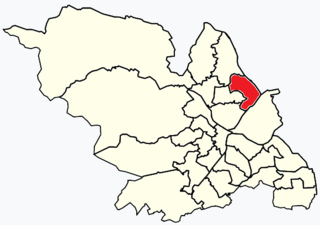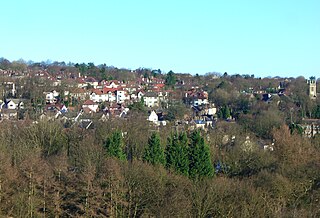
Pitsmoor is a former village, now a suburb of Sheffield, England. The name derives from Or-pits as, anciently, the main local industry was the mining of ore. [1] The village falls within the Burngreave ward of the City.

Pitsmoor is a former village, now a suburb of Sheffield, England. The name derives from Or-pits as, anciently, the main local industry was the mining of ore. [1] The village falls within the Burngreave ward of the City.
In 1906, thirteen Roman coins were found in the suburb. [2] In the late Middle Ages, the Duke of Norfolk was the lord of the manor and owned the large woods surrounding it, now almost all covered by housing. A coal mine was developed, with its entrance on what later became Grimesthorpe Road. Its outflow ran by the side of the lane as far as Burngreave Vestry Hall, where it was joined by a burn which rose in Old Park Wood. [1]
A small number of old houses survive in Pitsmoor, including Abbeyfield House and Toll Bar Cottage, which was built in 1837 on what was then the main road from Sheffield to Barnsley, Wakefield and Leeds. [3] A few more survive in Crabtree, formerly a separate hamlet, lying immediately north west of Pitsmoor. [1] Christ Church was constructed to serve the area in 1850, which was made its own parish. [4]
In the early 1900s houses were still being built in the area. If you take a walk up Burngreave Road from Spital Hill you can follow this progression uphill from the dates marked on the front of each villa on either side of the road. The people who lived in them were doctors, teachers, shopkeepers and business men. Pitsmoor was described as eminently respectable and a languorous and soothing suburb, in an article in the Sheffield Daily Telegraph in 1906.[ citation needed ] In 1909, Abbeyfield House and its grounds were purchased by Sheffield City Council for £10,500, the grounds becoming Abbeyfield Park. [5] In 1913, another patch of land off Abbeyfield Road became Devon Gardens. The creation of these public green spaces was in aid of an urban population of factory workers who needed access to fresh air and space to exercise.
During the 1920s some of the back-to-back houses began to disappear but many of the courts persisted until after the Second World War. Areas around Verdon Street and Gower Street were still dominated by this type of housing.
The King Mojo Club was based in Pitsmoor.

Attercliffe is an industrial suburb of northeast Sheffield, England on the south bank of the River Don. The suburb falls in the Darnall ward of Sheffield City Council.

Broomhill and Sharrow Vale — which includes the districts of Broomhill, Broomhall, Crookesmoor, Endcliffe, Sharrow Vale and Tapton Hill — is one of the 28 electoral wards in City of Sheffield, England. The ward was created following the 2015 local government boundary review out of parts of the old Broomhill, Central and Nether Edge wards. It is located in the western part of the city. The population of the Broomhill ward in 2011 was 16,966 people in 5,708 households, covering an area of 2.7 km2. Broomhill & Sharrow Vale is one of the wards that make up the Sheffield Central Parliamentary Constituency.

Crosspool is a suburb of the City of Sheffield, South Yorkshire, England, located 2.5 miles (4 km) west of the city centre. The suburb falls within the Crookes ward of the City of Sheffield. It is a middle class residential area in an elevated position above the Porter and Rivelin valleys and stands at around 660 feet (200 m) above sea level. Crosspool is situated on the A57 road and is the last suburb on that road before the city boundary and open countryside is reached. In 2011 Crosspool had a population of 6,703.

Southey ward—which includes the districts of Fox Hill, New Parson Cross, Southey, Wadsley Bridge, and part of Old Parson Cross—is one of the 28 electoral wards in City of Sheffield, England. It is located in the northern part of the city and covers an area of 1.8 square miles. The population of this ward in 2011 was 19,086 people in 8,295 households. It is one of the wards that make up the Sheffield Brightside and Hillsborough constituency.

Woodhouse ward—which includes the district of Woodhouse and most of Handsworth—is one of the 28 electoral wards in the City of Sheffield, England. It is located in the southeastern part of the city and covers an area of 2.7 square miles (7.0 km2). The population of this ward in 2011 was 17,450 people in 7,764 households. It is one of the wards that make up the Sheffield South East constituency.

Richmond is a suburb of Sheffield in South Yorkshire, England. It lies in the eastern part of the city.

Gleadless Valley ward—which includes the districts of Gleadless Valley, Heeley, Lowfield, and Meersbrook—is one of the 28 electoral wards in City of Sheffield, England. It is located in the southern part of the city and covers an area of 4.5 km2. The population of this ward in 2011 was 21,089 people in 9,516 households. It is one of the five wards that form the Sheffield Heeley parliamentary constituency in the House of Commons. Gleadless Valley actually describes the valley that separates Hemsworth from Herdings, and is a broad area that covers several housing estates: Hemsworth, Herdings and Rollestone. Gleadless Valley is bordered by Gleadless and Norton.

Whirlow is a suburb of the City of Sheffield in England, it lies 3.7 miles (6 km) south-west of the city centre. The suburb falls within the Dore and Totley ward of the City. It is one of the most affluent areas of Sheffield, with much high class housing and several notable small country houses within it. During the Victorian era it was home to some of Sheffield's most influential citizens. Whirlow straddles the A625, the main Sheffield to Hathersage road. The suburb covers the area from Parkhead in the north to Whirlow Bridge in the south and from Ecclesall Woods in the east to Broad Elms Lane in the west. Whirlow had a population of 1,663 in 2011.

Wadsley is a suburb of the City of Sheffield in South Yorkshire, England. It stands 3 miles (5 km) north-west of the city centre at an approximate grid reference of SK321905. At the 2011 Census the suburb fell within the Hillsborough ward of the City. Wadsley was formerly a rural village which was engulfed by the expansion of Sheffield in the early part of the 20th century.

Burngreave ward—which includes the districts of Burngreave, Fir Vale, Grimesthorpe, Pitsmoor, and Shirecliffe—is one of the 28 electoral wards in City of Sheffield, England. It is located in the northern part of the city and covers an area of 2.8 square miles. The population of this ward in 2011 was 27,481 people in 9,906 households. It is one of the wards that make up the Sheffield, Brightside and Hillsborough constituency. Most of the ward is served by a free community newspaper, the Burngreave Messenger.

Shiregreen and Brightside ward—which includes the districts of Brightside, Shiregreen, and Wincobank—is one of the 28 electoral wards in City of Sheffield, England. It is located in the northern part of the city and covers an area of 6.5 km2. The population of this ward in 2011 was 20,826 people in 8,696 households. It is one of the wards making up the Sheffield Brightside parliamentary constituency.

Abbeyfield is a park in Pitsmoor, Sheffield, South Yorkshire, England, bought by the City Corporation in 1909. The park comprises the park itself, a bowling green, as well as Abbeyfield House, a former secondary school. Abbeyfield School opened in 1919 and was the first school to be built outside Sheffield city centre as a result of the 1902 Act. The number of pupils was high and the school soon proved to be too small, children being split in numerous classes in several neighbouring churches. Brush House was converted into a school and some classes moved to that location. Abbeyfield House closed in September 1927 and all pupils moved to Brushes, then called Firth Park Secondary School.

Neepsend is a suburb of the city of Sheffield, it stands just 1 mile (1.6 km) north-west of the city centre. The main area of Neepsend covers the flood plain of the River Don from Lady's Bridge at the Wicker up to Hillfoot Bridge. The suburb falls within the Central Ward of the City. The adjacent district of Parkwood Springs is often regarded as part of the suburb.

Carbrook is an industrial area of Sheffield, South Yorkshire, England to the south-east of Brightside. The suburb is named for the Carr Brook, which ran through the area until the late eighteenth century.

Darnall is a suburb of eastern Sheffield, South Yorkshire, England. Darnall is approximately 3 miles (5 km) east-north-east of Sheffield city centre.

Burngreave is an inner city district of Sheffield, South Yorkshire, England lying north of the city centre. The population of the ward taken at the 2011 census was 27,481. It started to develop in the second half of the 19th century. Prior to this, this area was mostly covered by Burnt Greave wood. Most of the area of the wood is covered by Burngreave Cemetery which was built in 1860 and extended in the early 1900s. Grimesthorpe Lane, which runs through Burngreave, is a very old road that follows the course of the Roman Rig, a man-made defensive ridge—probably built by the Celtic Brigantes tribe—that used to run from near the Wicker to Mexborough.

Walkley is a suburb of Sheffield, England, west of Burngreave, south of Hillsborough and north-east of Crookes.

Upperthorpe is a suburb of the City of Sheffield, England. It lies 1.2 miles (2 km) west of the city centre. The suburb falls within the Walkley ward of the City. It is an area of residential housing and is bounded by the suburbs of Walkley to the north, Crookes to the west and Netherthorpe to the south.

Gleadless Valley is a housing estate and electoral ward of the City of Sheffield in England. The population of the ward at the 2011 Census was 21,089. It lies 2.5 miles (4.0 km) south-southeast of the city centre. Formerly a rural area, Gleadless Valley was developed as a large housing project with around 4000 dwellings by Sheffield City Council between 1955 and 1962. It is an area of undulating land drained by the Meers Brook, which has its source on the high ground in the woodland at Gleadless. Adjacent are Gleadless to the east, Norton to the south-west, Heeley to the west and Arbourthorne to the north.

Fulwood is a residential suburb and ward of the City of Sheffield in England, it lies 5.5 km west-southwest of the city centre. Formerly an ancient settlement and village on the Porter Brook, it became integrated into the city in the 1930s. It is bounded by the suburbs of Lodge Moor to the NW, Ranmoor to the east and Crosspool to the NE. The open countryside of the Peak District lies to the west and SW. The sub districts of Stumperlowe and Goole Green are part of the suburb. The population of the ward at the 2011 Census was 18,233. Fulwood is located in the Sheffield Hallam constituency which, as of the 2019 general election voted Labour.